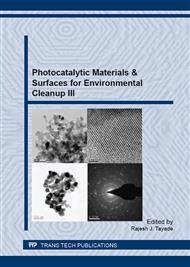[1]
N. Rao, B. Sivasankar, V. Sadasivam, Kinetic studies on the photocatalytic degradation of direct yellow 12 in the presence of ZnO catalyst, J. Mol. Catal. A: Chem. 306 (2009) 77-81.
DOI: 10.1016/j.molcata.2009.02.028
Google Scholar
[2]
B. Pare, S.B. Jonnalagadda, H.S Tomar, V.W. Bhagwat, P. Singh, ZnO assisted photocatalytic degradation of acridine orange in aqueous solution using visible irradiation, Desalination 232 (2008) 80-90.
DOI: 10.1016/j.desal.2008.01.007
Google Scholar
[3]
J. Wade, An Investigation of TiO2-ZnFe2O4 Nanocomposites for Visible Light Photocatalysis, Department of Electrical Engineering College of Engineering University of South Florida.
Google Scholar
[4]
M. Shang, W. Wang, L. Zhang, Preparation of BiOBr lamellar structure with high photocatalytic activity by CTAB as Br source and template, J. Hazard. Mater. 167 (2009) 803-809.
DOI: 10.1016/j.jhazmat.2009.01.053
Google Scholar
[5]
K.L. Zhang, C.M. Liu, F.Q Huang, C. Zheng, W.D. Wang, Study of the electronic structure and photocatalytic activity of the BiOCl photocatalyst, Appl. Catal. B: Environ. 68 (2006) 125-129.
DOI: 10.1016/j.apcatb.2006.08.002
Google Scholar
[6]
X. Zhang, Z.H. Ai, F.L. Jia, L.Z. Zhang, Generalized one-pot synthesis, characterization and photocatalytic activity of hierarchical BiOX (X= Cl, Br, I) nanoplates microspheres, J. Phys. Chem. C 112 (2008) 747-753.
DOI: 10.1021/jp077471t
Google Scholar
[7]
C. Wang, C. Shao, Y. Liuc, L. Zhang, Photocatalytic properties of BiOCl and Bi2O3 nanofibers prepared by electrospinning, Scripta Mater. 59 (2008) 332-335.
DOI: 10.1016/j.scriptamat.2008.03.038
Google Scholar
[8]
D.P. Bisena, R. Sharma, N. Brahmea, R. Tamrakar, Effect of temperature on the synthesis of CdS:Mn doped nanoparticles, Chalcogenide Letters 6 (2009) 427-431.
Google Scholar
[9]
L.C. Chen, C.M. Huang, F.R. Tsai, Characterization and photocatalytic activity of K+-doped TiO2 photocatalysts, J. Mol. Catal. A: Chem. 265 (2006) 133-140.
Google Scholar
[10]
APHA, Standard methods for examination of water and wastewater (American water workers Association, New York), 6th Edn (1985) 535.
Google Scholar
[11]
D. Sasanka, P.A. Joy, Synthesis and magnetic properties of Mn doped ZnO nanowires, Solid State Comm. 142 (2007) 190-194.
DOI: 10.1016/j.ssc.2007.02.017
Google Scholar
[12]
E.D. Jeong, P.H. Borse, J.S. Jang, J.S. Lee, O.S. Jung, H. Chang, J.S. Jina, M.S. Won, H.G. Kim, Hydrothermal synthesis of Cr and Fe co-doped TiO2 nanoparticle photocatalyst, J. Ceram. Proce. Res. 9 (2008) 250.
Google Scholar
[13]
C.Y. Wang, C. Bottcher, D.W. Bahnemann, J.K. Dohrmann, A comparative study of nanometer sized Fe (III)-doped TiO2 photocatalysts: synthesis, characterization and activity, J. Mater. Chem. 13 (2003) 2322-2325.
DOI: 10.1039/b303716a
Google Scholar
[14]
M. Asiltürka, F. Sayılkan, E.G. Arpac, Effect of Fe3+ ion doping to TiO2 on the photocatalytic degradation of malachite green dye under UV and vis-irradiation, J. of Photochem. Photobiol. A: Chem. 203 (2009) 64-71.
DOI: 10.1016/j.jphotochem.2008.12.021
Google Scholar
[15]
R. Ullah, J. Dutta, Photocatalytic degradation of organic dyes with manganese-doped ZnO nanoparticles, J. Hazard. Mater. 156 (2008) 194-200.
DOI: 10.1016/j.jhazmat.2007.12.033
Google Scholar
[16]
S.D. Sharma, K.K. Saini, Chander Kant, C.P. Sharma, S.C. Jain, Photodegradation of dye pollutant under UV light by nano-catalyst doped titania thin films, Appl. Catal B: Environ. 84 (2008) 233-240.
DOI: 10.1016/j.apcatb.2008.04.017
Google Scholar
[17]
T. Tong, J. Zhang, B. Tian, F. Chen, D. He, Preparation of Fe3+-doped TiO2 catalysts by controlled hydrolysis of titanium alkoxide and study on their photocatalytic activity for methyl orange degradation, J. Hazard. Mater. 155 (2008) 572–579.
DOI: 10.1016/j.jhazmat.2007.11.106
Google Scholar
[18]
B. Gao, A.K. Chakraborty, J.M. Yang, and W.I. Lee, Visible-light photocatalytic activity of BiOCl/Bi3O4Cl nanocomposites, Bull. Korean Chem. Soc. 31 (2010) 1941.
Google Scholar
[19]
F. Sayılkan, M. Asiltürk, P. Tatar, N. Kiraz, S. Sener, E. Arpac , H. Sayılkan, Photocatalytic performance of Sn-doped TiO2 nanostructured thin films for photocatalytic degradation of malachite green dye under UV and vis-lights, Mater. Res. Bull. 43 (2008) 127-134.
DOI: 10.1016/j.materresbull.2007.02.012
Google Scholar
[20]
I. Poulios, A. Avranas, E. Rekliti, A. Zouboulis, J. Chem. Technol. Biotechnol., 75 (2000) 205.
DOI: 10.1002/(sici)1097-4660(200003)75:3<205::aid-jctb201>3.0.co;2-l
Google Scholar
[21]
J. Bandara, J. Kiwi, Fast kinetic spectroscopy, decoloration and production of H2O2 induced by visible light in oxygenated solutions of the azo dye Orange II, New J. Chem. 23 (1999) 717.
DOI: 10.1039/a902425e
Google Scholar
[22]
S.H Yoon., J.H. Lee, Oxidation mechanism of As(III) in the UV/TiO2 system: evidence for a direct hole oxidation mechanism, Environ. Sci. Technol. 39 (2005) 9695.
DOI: 10.1021/es051148r
Google Scholar


